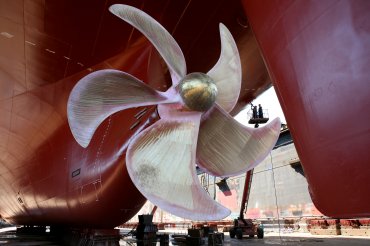
Marine industry classification society DNV GL, in cooperation with three marine insurers, has initiated a project to study whether biodegradable lubricants play a role in stern tube bearing failures.
Tests will compare the lubrication properties of biobased and biodegradable nontoxic marine lubricants, known as environmentally acceptable lubricants, to those of traditional, mineral oil-based products.

Photo courtesy of DNV GL
Marine industry classification society DNV GL will initiate a project to study whether biodegradable lubricants play a role in stern tube bearing failures by March 2018.
The United Kingdoms Leonardo Testing Services Ltd. will perform tests at the University of Sheffield laboratories. DNV GL will supervise the tests with its project partners, a consortium of Scandinavian marine insurers including the Swedish Club, Norwegian Hull Club, Gard and Skuld. Phase one of the program is scheduled for completion by the end of March. The results will be published later in 2018.
With this new study, we hope to gain a better understanding of factors influencing the lubrication performance of EALs, said ystein sheim Alnes, principle engineer for the Olso, Norway-based DNV GL, in a Jan. 16 press release. Speaking to Lube Report EMEA, Alnes explained that DNV GL did not have any technical reasons for conducting any detailed studies of [EALs] at the time of their introduction back in 2014. They were not common in the maritime industry.
Use of EALs increased following the United States Environmental Protection Agencys introduction of the 2013 Vessel General Permit, which requires all vessels longer than 79 feet to use EALs in all oil-to-sea interfaces, such as controllable pitch propellers, azimuth thrusters and paddle wheel propulsion systems.
Since then, some desktop studies have been conducted in order to map potential differences between typical EALs and mineral oils, Alnes continued. None of these studies revealed any alarming differences. The study we are conducting now is much more in-depth and targeting specific properties such as pressure-viscosity relationship at high shear rates and oil film formation and thickness.
The study will employ the universitys proprietary non-invasive ultrasonic technology to study the performance of lubricant films in real-time. The technology is able to precisely measure oil films in journal bearings, Alnes said, adding that the universitys expertise in tribology – the study of friction, lubrication and wear – gives it an edge over other institutions.
The team will be monitoring the formation of hydrodynamic oil films, the impact of load and temperature on thickness, and whether or not high shear rates result in shear thinning.
Shortly after VGP was reissued in 2013, marine propulsion suppliers began work on compliant propulsion packages, with companies such as Wrtsil being among the first to launch such packages in mid-2015.
According to the DNV GL, the increased application of EALs can also be credited to the advent of novel propulsion system designs, such as single stern tube bearing installations.
On top of that, the drive towards greater economic efficiency has prompted shipbuilders to outfit their growing transportation vessels with larger and heavier propellers, with additional weight and accompanying shaft forces putting a strain on the stern tube bearing design in general.
The single stern tube bearing design, in particular, has come under scrutiny following an increase in failures over the years. In a February 2016 report, Chris Leontopoulis of the American Bureau of Shipping concluded, among other things, that the probability of reaching negative misalignment angles is more readily possible in this design, compared with the traditional set-up comprising two stern tube bearings, as the latters forward stern tube bearing corrects the slope by taking the additional load.
The same report, titled Shaft Alignment Challenges – The Single Stern Tube Bearing Design, also listed lubrication system with potentially insufficient cooling among the contributing factors to related failures witnessed in recent years.
Depending on the results of its study, DNV GL could alter its rules and standards for classification. Rules are updated every six months, so any required updates can be put into force quite quickly if needed, Alnes said, concluding that he did not want to speculate on potential DNV GL rule updates as a result of the performance assessment of EALs.
DNV GL is a quality assurance and risk management company that provides classification, technical assurance, software and independent advisory services to maritime and other industries.